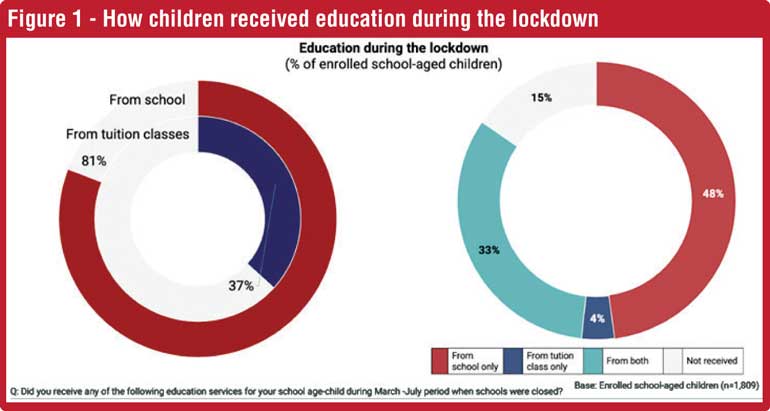Friday Dec 13, 2024
Friday Dec 13, 2024
Thursday, 9 December 2021 00:00 - - {{hitsCtrl.values.hits}}

A new survey shows that 85% of enrolled school-aged children had some form of education services during school closures between March and July 2020.
While some received educational services through multiple means, 54% of students received information, instructions, notes or assignments sent to smartphone, tab or computer, and 50% had live lessons delivered over Zoom and other applications (potentially alongside other methods). Sixty percent received education services through ‘offline’ methods like physical delivery of material (also potentially alongside other methods).
The 2021 island wide survey conducted by digital policy think tank LIRNEasia, showed that though 85% received some form of education services, only 48% relied exclusively on services from their school, while 4% relied exclusively on tuition providers and 33% relied on both.
The survey does not directly reveal information about the continuity, nor the quality of the education services provided, but the rate of dissatisfaction with the services provides some indication. Despite high access to remote education, over 58% of households were dissatisfied with their remote education experience.
Furthermore, inequalities in who had access were evident (e.g., children in better-off households being more likely to receive education) as well as what or how content was received (e.g., 50% had live online lessons while 50% did not). There were also inequalities in terms of receiving feedback, with just 48% receiving feedback and the balance 52% not.
According to Education Forum Sri Lanka Co-Convenor Dr. Sujata Gamage, “these survey data are consistent with ground realities. Soon after schools closed, teachers and local education authorities mobilised whatever resources were at their disposal, whether using WhatsApp messages or leaving notes and assignments at the school gate for collection, to reach out to their students. Parents seem to have risen up to the challenge as well by increasing their Internet access. Of the households with enrolled school-age children, 76% had access to the Internet in 2020, in contrast to the 34% of such households in 2018, according to LIRNEasia’s AfterAccess survey. Not surprisingly, 90% of the enrolled children living in internet-connected households received remote education services.”
The survey also highlighted some of the difficulties that households faced in their children accessing education during this time, ranging from poor signal quality, to not having enough devices to go around in the house and as stated, many remained dissatisfied with the entire experience.
The survey findings were released at a virtual launch event conducted on 8 December, which included a panel discussion with leading Government, private sector and civil society representatives. Panellists included Telecommunications Regulatory Commission of Sri Lanka Director General and ICT Agency of Sri Lanka Chairman Oshada Senanayake, Secretary of Education, Cultural Affairs, Sports and Youth Affairs of the Northern Provincial L. Ilaangovan, PickMe Founder and CEO Jiffry Zulfer, CEPA Team Leader for Sustainable Development Karin Fernando, and LIRNEasia Senior Research Manager Gayani Hurulle. The discussion was moderated by LIRNEasia Chair Rohan Samarajiva.